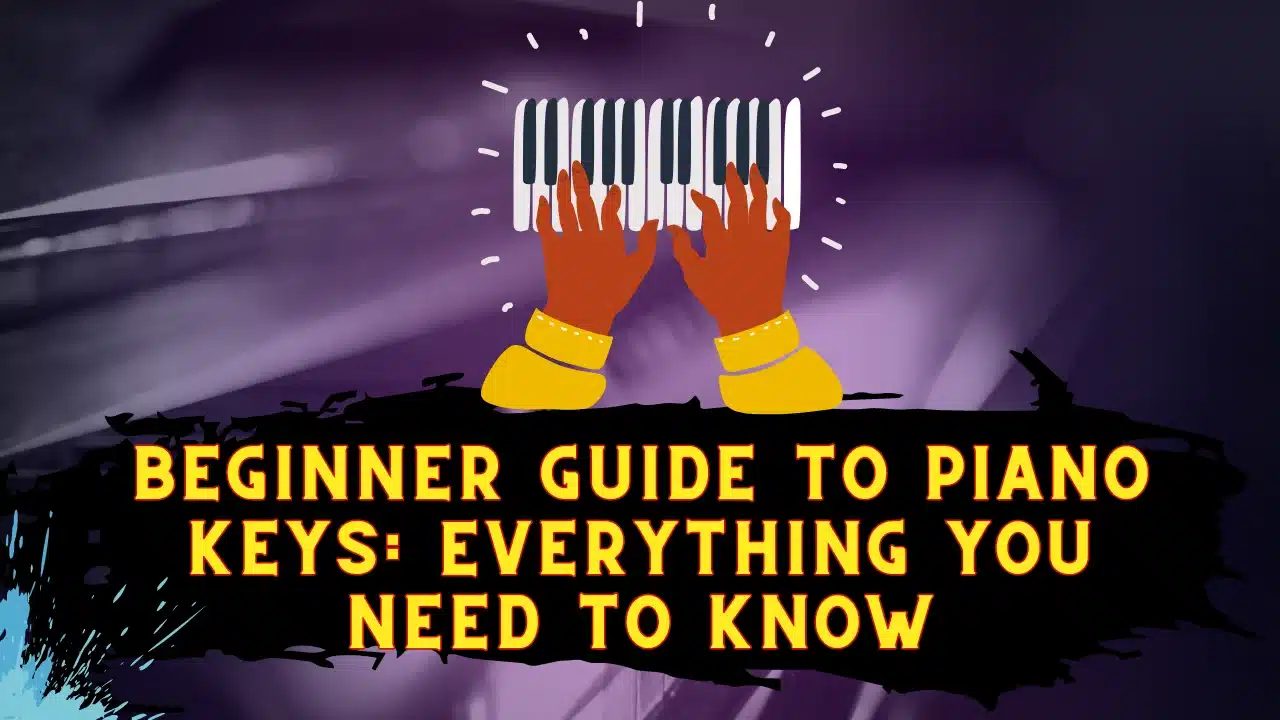Learning piano is not a difficult task, but it seems a little complicated at the beginning when you look at the piano keys. But don’t worry! It is easier to grasp the structure of the piano than it may seem. Whether you’re new to the piano or looking for a refresher, this guide will cover all the basics you need to know about piano keys with helpful tips and descriptions to aid your memory. First let’s start with piano keys layout. Followed by piano key names.
Understanding the Layout of the Piano Keys
A standard piano key layout is composed of 88 keys which are categorized into 52 white keys and 36 black keys. These keys are repeated in a manner that goes across the whole piano and by mastering this sequence, anyone could get comfortable with the piano.
Quick Memory Trick: The Chopsticks & Pattern of Piano Keys
Once you understand the piano keys pattern, observe the pattern on the black keys particularly. You will realize that they are arranged in pairs and triplets. It continues like this all the way to the top and bottom of the piano. Use these groups as landmarks:
- The two black keys resembling chopsticks are always succeeded by three white keys (C, D, E).
- The three black keys arranged like a fork are followed by four white keys (F, G, A, B).
This simple piano key patterns can help you know where you are on the piano.
The White Keys: Notes from A to G
The white keys on the piano are named after the first seven letters of the alphabet: A, B, C, D, E, F and G. After G, the pattern resets at A. Here are some ways to easily remember where some of these notes are:
- C is always the white key just to the left of the group of two black keys.
- F is always the white key just to the left of the group of three black keys.
Memory Clues for White Piano Keys
- “C is to the left of the 2.” Remember, C is to the left of the group of 2 black keys.
- “F is to the left of the 3.” Remember, F is to the left of the group of 3 black piano keys.
Understanding the positions of C and F will assist you in identifying the white keys as they consistently follow this sequence of notes: A, B, C, D, E, F, G.
The Black Keys: Sharps and Flats Explained
The black keys on the piano represent sharps (♯) and flats (♭) serving as the in between notes, among the white contributing to musical harmony and expression. Here’s a breakdown of how these keys come into play:
- A sharp (♯) indicates that you should play the note that comes right after a white key, on a piano or keyboard. For example, C♯ is the black key immediately to the right of C.
- A flat (♭) means hitting the note before a white key on the piano. For example, D♭ is the black key immediately to the left of D.
Each black key on a piano can be referred to by two names based on whether it is being used as a sharp or a flat note. For example the black key, between C and D can be identified as either C♯ or D♭.
Memory Clues for Black Piano Keys
- “Sharps go right; flats go left.” This simple trick can guide you on the direction to locate sharps or flats.
- “Skip a white, find a black.” Remember that each black key is positioned between two white keys to help you identify sharps and flats.
History of the 88-Key Standard
It was not easy to get to the 88-key standard and it required a little evolution. The first types of piano did not have a key range of five or more octaves that is evident in modern types of pianos; the early ones that were being produced in the early 1700s only had 49 piano keys. Since music was developing, it required greater variety and more intense emotional expressiveness, which is why additional keys were incorporated.
Soon enough in the late 1800s piano manufacturers like Steinway introduced the 88-key models which quickly gained popularity. That enabled the composers to add for making the musical pieces more interesting, using the upper and lower octaves.

Did You Know?
The piano was originally called as Pianoforte, because it can be played at different levels of loudness “Piano-Soft” and “Forte-Loud”
Variations in Key Count
Not all of the pianos and keyboards that are present in the market have the said number of piano keys. Depending on the type and purpose, the number of can vary significantly:
- Shorter Keyboards (61 or 76 piano keys): These versions are generally smaller in size and lighter and can be observed in most of the digital keyboards that are used. They are good especially when you are just starting off, or when you don’t have so much space to work with.
- 61 keys on piano: Cover five octaves (C2 to C7), suitable for basic practice and learning.
- 76 keys on piano: Cover six octaves (E1 to G7), offering more range but still less than a full piano.
- Extended Range Pianos (97 or more keys): There are special models of pianos which are made with more than 88 keys. For example, the Bösendorler Imperial Grand model has 97 keys and the key begins at C0 level. These additional keys are primarily incorporated in some of the selected classical and modern pieces.
- Smallest Pianos (49 keys or fewer): These are the small instruments which are the toy pianos or the ultra-small piano for children or absolute beginners who cannot play on a minimum five-octave instrument.
Different Types of Pianos and Their Keys
Understanding the differences in key counts also means exploring various types of pianos:
- Grand Pianos: These possess the full 88 keys that offer the best sound quality since they possess long strings along with wider sounding boards. They are most commonly placed in concert halls, recording studios and homes of musicians or music producers.
- Upright Pianos: Often they are 88 key instruments but they are slightly smaller than grand pianos, with strings that are placed vertically. Most of them are intended for home use and music schools.
- Digital Pianos: These can be of 61, 76 or 88 keys. Some of them come with weighted keys similar to acoustic pianos whereas some of them can have some other features like different types of instruments, recording options etc.
- Stage Pianos and Synthesizers: These are commonly built with either 61 or 76 keys, and it is designed for live performances, and they are portable. Most often they tend to focus on optimum performance as much as possible and might include any form of sound or noise.
- Portable Piano: These are most often the ones with the least number of keys, 61 keys or even fewer for beginners or for traveling performers in most cases. They are more compact and affordable than digital pianos, however the keys may not be weighted as in the case of ordinary pianos.

Did You Know?
Even though the piano uses a keyboard it’s a percussion instrument. A hammer inside hits the string producing a sound
Key Count for Various Expertise
To beginners, the idea of using all the 88 keys could feel like a much harder task at first. In fact, most beginners and intermediate level songs are not actually written to use the entire range of the piano in the first place. Here’s a quick breakdown of who might need different key counts:
- Beginners and Casual Players: A 61-key or a 76-key piano is often more than adequate for education and playing most of the upbeat music of today and basic classical music.
- Intermediate Players: As your skills develop, it will be more advantageous to own a full 88 keys piano especially when playing classical or complex contemporary music.
- Advanced Players and Professionals: For complex compositions especially in classical music, all keys on the piano are important and thus opting for the model with all 88 piano keys is advisable. This makes it easier to portray the depth and versatility that the kind of music requires.
Octaves: Understanding the Repeating Patterns
An octave is a series of eight piano key notes that ascend and descend within the same pitch degree. For example C to C or G to G. Octaves are useful because the same notes can be produced at different pitches, high or low. A piano has several octaves with the possibility of having more than one C, D, E, and the rest of the piano key notes.
Each octave follows the same pattern of piano keys: A, B, C, D, E, F, G. This repetition makes it easier to move across the piano and locate any key that may be desired.
Finding Middle C: Your Starting Point
Middle C is a significant note in learning how to play the piano especially if you are learning in the initial stages. It’s centralized on the piano and is the white key immediately left to two black keys forming a group in the mid section of the piano. Middle C is one of the first notes that students learn because it is easy to locate and can be used as a reference point in several beginner’s tunes and workouts.
Tip
Apply a small sticker beside Middle C so that you don’t have to search for it every time.
Scales: The Foundation of Piano Playing
A scale is accurately a sequence of notes as per the order and one of the most familiar is the C major scale, which includes only the white keys. Playing scales is one of the best techniques anyone can use to adapt to the piano.
C Major Scale:
- The notes are C, D, E, F, G, A, B, C.
- To play it, start on the note C and play every white key till the next C.
Chords: Playing Multiple Notes Together
Playing chords involves combining notes simultaneously to create harmony in music and is a fundamental aspect of music performance when playing songs. A basic chord known as a chord consists of three notes. Such, as the C Major chord formed by the notes C,E and G.
Conclusion
When it comes to learning how to play the piano the first thing that one needs to do is to get used to the piano keys. If you learn about the white and black keys, the scales and the fundamental chords you can quite easily start with a strong ground. Please do not rush through the lessons, use the memory tricks explained here and above all, have fun while practicing. As you move forward, you will be able to play your preferred songs without straining yourself. But if you are stuck in any phase of you piano learning it is always advisable to consult with piano experts. Happy Playing!

































